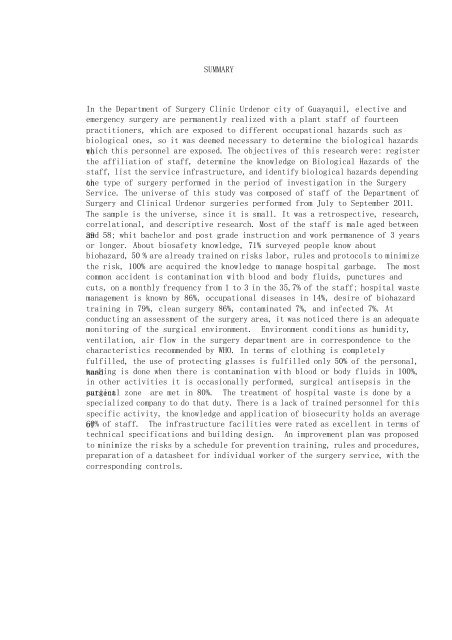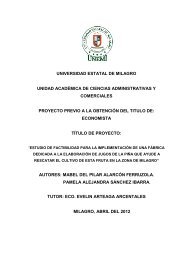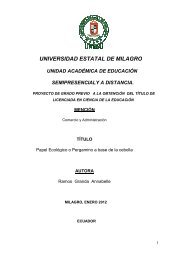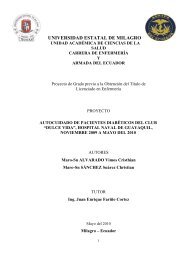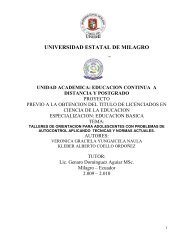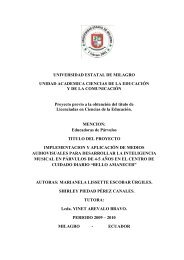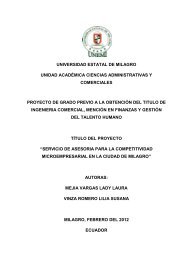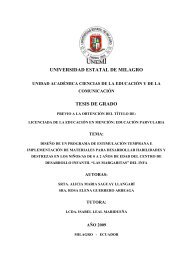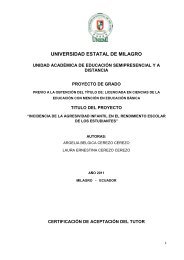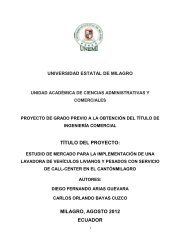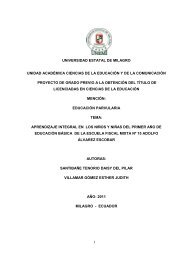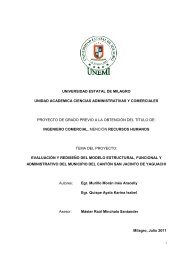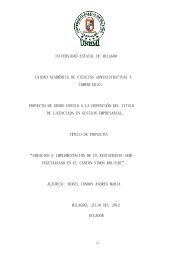repúbica del ecuador universidad estatal de milagro diploma ...
repúbica del ecuador universidad estatal de milagro diploma ...
repúbica del ecuador universidad estatal de milagro diploma ...
You also want an ePaper? Increase the reach of your titles
YUMPU automatically turns print PDFs into web optimized ePapers that Google loves.
SUMMARY<br />
In the Department of Surgery Clinic Ur<strong>de</strong>nor city of Guayaquil, elective and<br />
emergency surgery are permanently realized with a plant staff of fourteen<br />
practitioners, which are exposed to different occupational hazards such as<br />
biological ones, so it was <strong>de</strong>emed necessary to <strong>de</strong>termine the biological hazards<br />
to which this personnel are exposed. The objectives of this research were: register<br />
the affiliation of staff, <strong>de</strong>termine the knowledge on Biological Hazards of the<br />
staff, list the service infrastructure, and i<strong>de</strong>ntify biological hazards <strong>de</strong>pending<br />
on the type of surgery performed in the period of investigation in the Surgery<br />
Service. The universe of this study was composed of staff of the Department of<br />
Surgery and Clinical Ur<strong>de</strong>nor surgeries performed from July to September 2011.<br />
The sample is the universe, since it is small. It was a retrospective, research,<br />
correlational, and <strong>de</strong>scriptive research. Most of the staff is male aged between<br />
39 and 58; whit bachelor and post gra<strong>de</strong> instruction and work permanence of 3 years<br />
or longer. About biosafety knowledge, 71% surveyed people know about<br />
biohazard, 50 % are already trained on risks labor, rules and protocols to minimize<br />
the risk, 100% are acquired the knowledge to manage hospital garbage. The most<br />
common acci<strong>de</strong>nt is contamination with blood and body fluids, punctures and<br />
cuts, on a monthly frequency from 1 to 3 in the 35,7% of the staff; hospital waste<br />
management is known by 86%, occupational diseases in 14%, <strong>de</strong>sire of biohazard<br />
training in 79%, clean surgery 86%, contaminated 7%, and infected 7%. At<br />
conducting an assessment of the surgery area, it was noticed there is an a<strong>de</strong>quate<br />
monitoring of the surgical environment. Environment conditions as humidity,<br />
ventilation, air flow in the surgery <strong>de</strong>partment are in correspon<strong>de</strong>nce to the<br />
characteristics recommen<strong>de</strong>d by WHO. In terms of clothing is completely<br />
fulfilled, the use of protecting glasses is fulfilled only 50% of the personal,<br />
hand washing is done when there is contamination with blood or body fluids in 100%,<br />
in other activities it is occasionally performed, surgical antisepsis in the<br />
patient surgical zone are met in 80%. The treatment of hospital waste is done by a<br />
specialized company to do that duty. There is a lack of trained personnel for this<br />
specific activity, the knowledge and application of biosecurity holds an average<br />
of 60% of staff. The infrastructure facilities were rated as excellent in terms of<br />
technical specifications and building <strong>de</strong>sign. An improvement plan was proposed<br />
to minimize the risks by a schedule for prevention training, rules and procedures,<br />
preparation of a datasheet for individual worker of the surgery service, with the<br />
corresponding controls.


